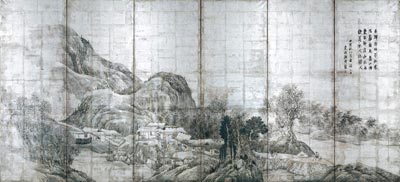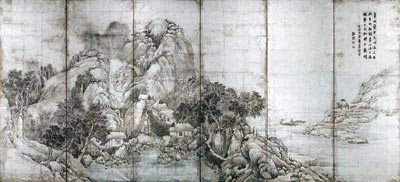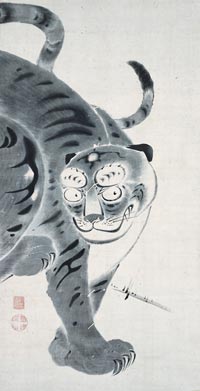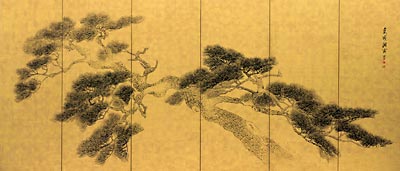Many phenomenal artists were active during Jakuchū’s lifetime in the
eighteenth century. This exhibition presents works by Yosa Buson (1716–1783), Ike Taiga
(1723–1776), Soga Shōhaku (1730–1781), Maruyama Ōkyo (1733–1795), and Katsu
Jagyoku (1735–1780).

 |
 |
10 Yosa Buson, Silver Landscape, MIHO MUSEUM Buson painted this work a year before his death.
It was displayed for the first time in public during in the
exhibition Yosa Buson: On the Wings of Art last year. |
9 Tiger, Sekihō-ji Temple, Kyoto


In his later years, Jakuchū lived with his daughter
near Sekihō-ji Temple in Fukakusa, Kyoto, and assumed the pseudonym
“Beitoō (‘old man of one bushel of rice’),” because he is said to have
received a bushel of rice for a painting. Each time, he would take the
money he received to a stone carver who he commissioned to sculpt an
image that he himself designed. The five hundred stone arhats (Buddhist
sages) at Mount Sekimine represents Jakuchū’s attempt to reenact the
life of the Buddha through these statues.
The great artist died on September 10, 1800, at the ripe old age of eighty-five. Even in his old age, however, he continued to produce innovative and amusing works such as his stone statues and paintings.
The great artist died on September 10, 1800, at the ripe old age of eighty-five. Even in his old age, however, he continued to produce innovative and amusing works such as his stone statues and paintings.

11 Yosa Buson, Old Pine (right screen), Private Collection
Buson produced this painting two years before he
died. It has not been exhibited for seventy-seven years, since 1932.

Hiroyuki Kano (Professor, Faculty of Culture and Information Science,
Doshisha University)
Nobuo Tsuji (Director of MIHO MUSEUM)
Nobuo Tsuji (Director of MIHO MUSEUM)
Other works on exhibit

Ike Taiga, Su Dongpo and Meng Jia,
Feinberg Collection, U.S.A.*
Soga Shōhaku, Hawk and Crane Flying over Waves,
Private Collection
Maruyama Ōkyo, Mount Fuji and Pines along Shore,
Chiba City Museum of Art
Katsu Jagyoku, Snake with Ball,
Private Collection*
*Newly discovered work.
Ike Taiga, Su Dongpo and Meng Jia,
Feinberg Collection, U.S.A.*
Soga Shōhaku, Hawk and Crane Flying over Waves,
Private Collection
Maruyama Ōkyo, Mount Fuji and Pines along Shore,
Chiba City Museum of Art
Katsu Jagyoku, Snake with Ball,
Private Collection*
*Newly discovered work.
| * | Reservations must be made in advance by phone. Please call MIHO MUSEUM Public Relations Office, tel. 0748-82-3411 |
| * | Numbered tickets will be passed out at the reception desk on the day of the lecture. |
| * | Free with entrance museum entrance. |